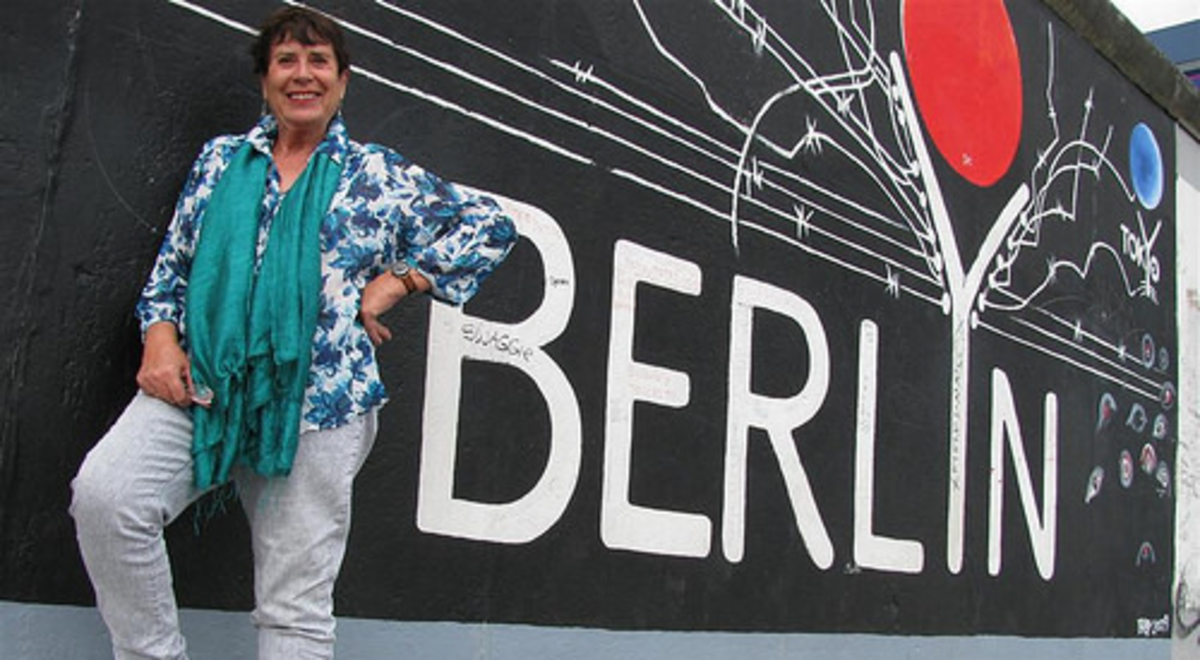Berlin was always near the top of my travel wish list and last spring, in early May, with majestic horse chestnut trees in full bloom, purple lilacs scenting the air, and tall linden trees lining the boulevards, I was actually there.
I visited the notorious Checkpoint Charlie – the “crossing” between former East and West Berlin; I walked over the same bridge as the literary Spy Who Came in from the Cold; I had my photograph taken at the iconic Brandenburg Gate; was dazzled by Berlin’s biggest and best theatre spectacular; was reduced to tears at the Holocaust Memorial, flinched at the sight of the intimidating Reichstag, and shopped on the glitzy Kurfürstendamm.
I even got a certificate from the Visit Berlin Tourist Office proclaiming: “Ich bin ein Berliner”.
What I shall take away more than anything, however, are my memories of the Berlin Wall.
Let’s remember some 20th century European history. Germany is defeated by the Allies in World War II. Berlin is carved up by the victors into the East and Western sectors at the end of the War. West Berlin becomes an island of democracy, literally walled off by the Russians, who turn East Berlin and East Germany into a Socialist terror state. The Wall comes down after 28 years in 1989, and the process of German reunification begins.
But the Wall today is still everywhere. Graffiti-covered sections occur on street corners, long swathes of it are left as memorials, while the East Side Gallery, a 1.3km-long section of wall near the city centre, showcases 105 murals by international artists and has become an international memorial for freedom. I shuddered at The Mortal Kiss by Dmitri Vrubel, which shows East German leader Erich Honecker and Russian leader Leonid Brezhnev in their infamous mouth-to-mouth kiss because of what it symbolises – the subjection, oppression and fear that Russia imposed on a conquered people.
At Potsdam, a beautiful little city of 18th century buildings and parks designed and built by Frederick the Great, my small group of journalists is taken into the room where the historic Potsdam Treaty was signed in 1945 by Churchill, Stalin and Truman. Our guide, Kevin Kennedy (“not a very German name, but I’m the son of an American GI”), a specialist in 20th century history, tells us why the meetings between the three leaders of the then free world only started at 5pm each day.
“Stalin drank six bottles of red Georgian wine each night, whilst Churchill downed a bottle of fine brandy. Harry Truman, moderate in contrast, only drank a Bourbon before breakfast so was keen to start earlier. The other two wouldn’t hear of it …”
Draw your own conclusions.
And it was while in Potsdam, once the centre and symbol of Prussian militarism, that Truman received the fateful telegram from America saying that “Little Boy” was now ready, and gave the order for the atomic bomb to be dropped on Hiroshima.
From Potsdam it was on to Halle, another delightful medieval city now restored and renovated from the obligatory taxes that all Germans today are required to pay towards the restoration of former East Germany.
Leipzig was next – Saxony’s pulsating city and most popular destination in Germany for culture-lovers, with a history stretching back over 1 000 years.
In the classically beautiful but simple late 1950s Opera House, at the opening of the annual German Travel Mart – my reason for being in Germany – the Mayor brimmed with passion for his city as he talked us through its medieval past, its royal past, the “Peaceful Revolution” of 1989 and the last 20 years of its lightning journey from the Iron Curtain days to the vibrant, arty city it is today.
People, especially young ones, poured out of the city after reunification, but now young people are coming back and the city is alive with energy. It’s a shopping mecca, a historian’s delight, a music lover’s paradise and an art enthusiast’s dream.
It’s also a city of music. The day before, I’d visited the 800-year-old St Thomas Boys Choir, the Bach Museum (Johann Sebastian lived and worked in Leipzig for years), the Richard Wagner Memorial Site, the Mendelssohn House and the Museum of Musical Instruments, which houses one of the world’s largest collections of musical instruments.
And if you need a break from city life, then take a boat trip under the bridges on the canals that meander through the city, where the indigenous vegetation is once again flourishing.
It’s no wonder that Germany attracts so many tourists and has become a top European travel destination. It really has it all – history, culture, good food, wonderful public transport – and is comparatively much more affordable than England or France, offering very good value for money.






